How The Piano Note Chart Was First Conceived
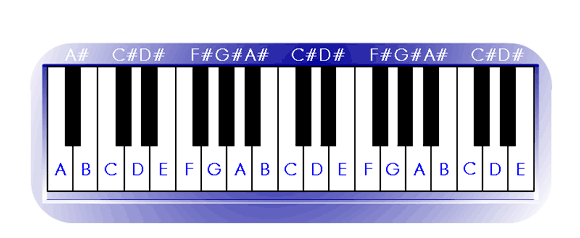 Okay, we all know what this is… right?
Okay, we all know what this is… right?
It’s the keyboard layout of a piano note chart. I’m sure as soon as you saw it, you knew exactly what it was. And if you’ve had a piano lesson or two, you may already know the names of some of the piano key notes.
But have you ever wondered why Middle C is known as “C” and not Middle “Q”? Or why is an “A” note not called an “H” note or an “M”, or any other letter of the alphabet?
Whose bright idea was it to group the black keys together in sets of twos and threes? Is it possible the piano key chart could have been designed in a different way?
Hmm… like this perhaps…

Seems a bit silly, I know. This is obviously a fictitious keyboard design. But I’ll bet you never thought to question why the piano key layout was designed the way it is.
One thing’s for sure… it didn’t happen by chance. There is a definite musical science behind how the pattern of the piano note chart was first conceived and developed. And it all starts a long, long… long time ago…
The First Seven Notes.
When early musicians were discovering music for the first time, creating the first musical instruments and establishing the language of music, they had to figure out exactly how many different notes they had to play with.
Whether it’s the plucking sound from a bow and arrow or the barking of a large dog, all audible sounds have a pitch and a certain number of frequency oscillations per second (from 20 to 20,000 hertz).
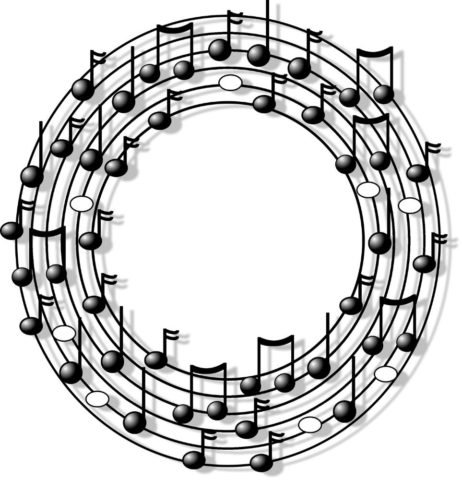 For example: the average car horn honks in the key of F# minor and often consists of two musical tones sounding together (F# and A).
For example: the average car horn honks in the key of F# minor and often consists of two musical tones sounding together (F# and A).
Strangely, when the first piano keyboard instrument was being invented in Greece over 2300 years ago, it was designed with only seven basic notes.
And just like today’s modern piano keyboard, these seven notes repeated themselves within a specific pattern throughout the length of the piano note chart.
However, this ancient piano key layout had a drastically different appearance from that of a modern piano keyboard because it was missing the “accidental” keys (what we call the black keys today).
One basic similarity between the ancient and the modern piano key chart is that the wooden keys were aligned horizontally with the lowest (bass) notes beginning on the left and gradually leading up into the higher (treble) notes on the right.
By pressing each piano key note in sequential order from left to right, early musicians realized that the first seven tones all had a uniquely different sound, which set them apart as individual notes.
However, the eighth tone sounded just like the harmonic equivalent of the first tone (only with double the frequency ratio). If played together, these two tones sounded in unison and would become known as an “octave”.
It was determined that these two identical tones were indeed the same note, and therefore, the sequential order of piano key notes simply repeated itself after the seventh note. This explains why the early piano note chart only had seven notes.
These seven musical notes were given names based on the first seven letters of the Latin alphabet:
A, B, C, D, E, F & G
How Seven Notes Became Twelve Notes
By the year 757 AD, the world’s first keyboard instrument, known as the “Hydraulis“, had finally found its way into the western world where the Catholic Church adopted it. This is where it would undergo a series of transformations over the next five centuries and evolve into the first modern church organ.
However, as late as the year 1200 AD the medieval church organ was still only using the same seven notes it originally inherited from its ancestor.
It soon became apparent that this limited version of the piano note chart lacked harmonic diversity and forced organ players to use only a finite number of harmonic scales, modes and chords.
As the medieval church organist continued to push beyond the boundaries of early music composition and experiment with different theories in music, the original seven piano key notes were eventually joined with five additional (and very useful) “half-tones”…
If you study the modern piano key layout, you’ll see that it is structured around the harmonic key of C major/A natural minor.
What this means is that the white notes on the piano note chart contain all the necessary tones to play both the C major and A natural minor scales without playing a single black note.
You may find it interesting to know that the very first keyboard instrument built in 250 BC, was also designed in the key of C major/A natural minor.
Of course, the big difference is that the piano key chart of that time did not yet contain the “accidental keys” (the black notes).
But without the black keys, you can imagine how limited early musicians were in their ability to create complex sounding music compositions.
Take for example, the C major scale (C, D, E, F, G, A, B, C). This is the probably the most popular string of notes ever played, and can best be described as:
“Doe, Ray, Me, Fa, So, La, Ti, Doe”
Of course these are very cheerful musical tones. But after a few centuries of playing in only two key signatures, medieval keyboard players probably began to realize that their early version of the keyboard was incomplete.
So sometime during the 13th century AD, the five accidental “half-tones” (C#, D#, F#, G# and A#) were all discovered and introduced to the piano note chart.
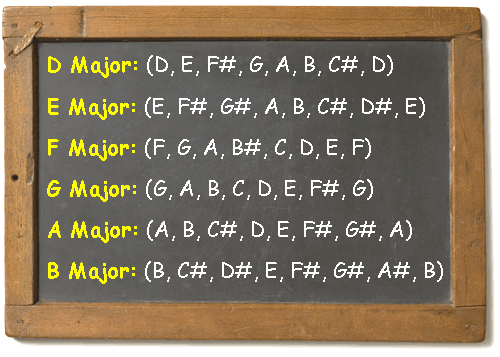 The incorporation of these five additional piano key notes, gave the world of music a wide variety of scales and modes, fourteen new key signatures, and an almost infinite number of chord possibilities.
The incorporation of these five additional piano key notes, gave the world of music a wide variety of scales and modes, fourteen new key signatures, and an almost infinite number of chord possibilities.
For example: in addition to the C major scale: (C, D, E, F, G, A, B, C) which uses only the white keys, keyboard players could now compose music based on the major scales of other individual notes (with the use of the black keys):
Over the next 700 years, this new and improved chromatic piano key layout began to shape the earliest sounds of what would become western music.
It also launched the medieval church organ on a path of continued growth, mechanical sophistication and elaborate design.
But it was the 18th century that ushered in the golden age of the pipe organ with a culmination of organ works composed by the most celebrated organist the world had ever know: Johann Sebastian Bach.
Many of Bach’s most groundbreaking compositions, such as the eerily familiar “Toccata In D Minor For Organ” would not have been possible if the five “accidental” keys had not been added to the early version of the piano note chart.
How The Piano Note Chart Was First Conceived
Okay, we all know what this is… right?
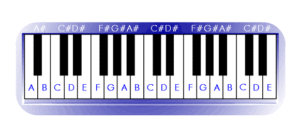 It’s the keyboard layout of a piano note chart. I’m sure as soon as you saw it, you knew exactly what it was. And if you’ve had a piano lesson or two, you may already know the names of some of the piano key notes.
It’s the keyboard layout of a piano note chart. I’m sure as soon as you saw it, you knew exactly what it was. And if you’ve had a piano lesson or two, you may already know the names of some of the piano key notes.
But have you ever wondered why Middle C is known as “C” and not Middle “Q”? Or why is an “A” note not called an “H” note or an “M”, or any other letter of the alphabet?
Whose bright idea was it to group the black keys together in sets of twos and threes? Is it possible the piano key chart could have been designed in a different way?
Hmm… like this perhaps…

Seems a bit silly, I know. This is obviously a fictitious keyboard design. But I’ll bet you never thought to question why the piano key layout was designed the way it is.
One thing’s for sure… it didn’t happen by chance. There is a definite musical science behind how the pattern of the piano note chart was first conceived and developed. And it all starts a long, long… long time ago…
The First Seven Notes
When early musicians were discovering music for the first time, creating the first musical instruments and establishing the language of music, they had to figure out exactly how many different notes they had to play with.
Whether it’s the plucking sound from a bow and arrow or the barking of a large dog, all audible sounds have a pitch and a certain number of frequency oscillations per second (from 20 to 20,000 hertz).
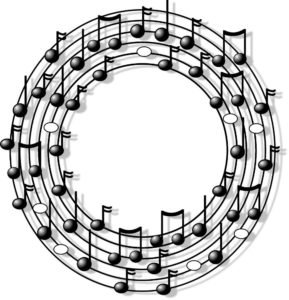 For example: the average car horn honks in the key of F# minor and often consists of two musical tones sounding together (F# and A).
For example: the average car horn honks in the key of F# minor and often consists of two musical tones sounding together (F# and A).
Strangely, when the first piano keyboard instrument was being invented in Greece over 2300 years ago, it was designed with only seven basic notes.
And just like today’s modern piano keyboard, these seven notes repeated themselves within a specific pattern throughout the length of the piano note chart.
However, this ancient piano key layout had a drastically different appearance from that of a modern piano keyboard because it was missing the “accidental” keys (what we call the black keys today).
One basic similarity between the ancient and the modern piano key chart is that the wooden keys were aligned horizontally with the lowest (bass) notes beginning on the left and gradually leading up into the higher (treble) notes on the right.
By pressing each piano key note in sequential order from left to right, early musicians realized that the first seven tones all had a uniquely different sound, which set them apart as individual notes.
However, the eighth tone sounded just like the harmonic equivalent of the first tone (only with double the frequency ratio). If played together, these two tones sounded in unison and would become known as an “octave”.
It was determined that these two identical tones were indeed the same note, and therefore, the sequential order of piano key notes simply repeated itself after the seventh note. This explains why the early piano note chart only had seven notes.
These seven musical notes were given names based on the first seven letters of the Latin alphabet:
A, B, C, D, E, F & G
How Seven Notes Became Twelve Notes
By the year 757 AD, the world’s first keyboard instrument, known as the “Hydraulis“, had finally found its way into the western world where the Catholic Church adopted it. This is where it would undergo a series of transformations over the next five centuries and evolve into the first modern church organ.
However, as late as the year 1200 AD the medieval church organ was still only using the same seven notes it originally inherited from its ancestor.
It soon became apparent that this limited version of the piano note chart lacked harmonic diversity and forced organ players to use only a finite number of harmonic scales, modes and chords.
As the medieval church organist continued to push beyond the boundaries of early music composition and experiment with different theories in music, the original seven piano key notes were eventually joined with five additional (and very useful) “half-tones”…
If you study the modern piano key layout, you’ll see that it is structured around the harmonic key of C major/A natural minor.
What this means is that the white notes on the piano note chart contain all the necessary tones to play both the C major and A natural minor scales without playing a single black note.
You may find it interesting to know that the very first keyboard instrument built in 250 BC, was also designed in the key of C major/A natural minor.
Of course, the big difference is that the piano key chart of that time did not yet contain the “accidental keys” (the black notes).
But without the black keys, you can imagine how limited early musicians were in their ability to create complex sounding music compositions.
Take for example, the C major scale (C, D, E, F, G, A, B, C). This is the probably the most popular string of notes ever played, and can best be described as:
“Doe, Ray, Me, Fa, So, La, Ti, Doe”
Of course these are very cheerful musical tones. But after a few centuries of playing in only two key signatures, medieval keyboard players probably began to realize that their early version of the keyboard was incomplete.
So sometime during the 13th century AD, the five accidental “half-tones” (C#, D#, F#, G# and A#) were all discovered and introduced to the piano note chart.
The incorporation of these five additional piano key notes, gave the world of music a wide variety of scales and modes, fourteen new key signatures, and an almost infinite number of chord possibilities.

For example: in addition to the C major scale: (C, D, E, F, G, A, B, C) which uses only the white keys, keyboard players could now compose music based on the major scales of other individual notes (with the use of the black keys):
Over the next 700 years, this new and improved chromatic piano key layout began to shape the earliest sounds of what would become western music.
It also launched the medieval church organ on a path of continued growth, mechanical sophistication and elaborate design.
But it was the 18th century that ushered in the golden age of the pipe organ with a culmination of organ works composed by the most celebrated organist the world had ever know: Johann Sebastian Bach.
Many of Bach’s most groundbreaking compositions, such as the eerily familiar “Toccata In D Minor For Organ” would not have been possible if the five “accidental” keys had not been added to the early version of the piano note chart.
How The Piano Note Chart Was First Conceived

Okay, we all know what this is… right?
It’s the keyboard layout of a piano note chart. I’m sure as soon as you saw it, you knew exactly what it was. And if you’ve had a piano lesson or two, you may already know the names of some of the piano key notes.
But have you ever wondered why Middle C is known as “C” and not Middle “Q”? Or why is an “A” note not called an “H” note or an “M”, or any other letter of the alphabet?
Whose bright idea was it to group the black keys together in sets of twos and threes? Is it possible the piano key chart could have been designed in a different way?
Hmm… like this perhaps…

Seems a bit silly, I know. This is obviously a fictitious keyboard design. But I’ll bet you never thought to question why the piano key layout was designed the way it is.
One thing’s for sure… it didn’t happen by chance. There is a definite musical science behind how the pattern of the piano note chart was first conceived and developed. And it all starts a long, long… long time ago…
The First Seven Notes
When early musicians were discovering music for the first time, creating the first musical instruments and establishing the language of music, they had to figure out exactly how many different notes they had to play with.
Whether it’s the plucking sound from a bow and arrow or the barking of a large dog, all audible sounds have a pitch and a certain number of frequency oscillations per second (from 20 to 20,000 hertz).

For example: the average car horn honks in the key of F# minor and often consists of two musical tones sounding together (F# and A).
Strangely, when the first piano keyboard instrument was being invented in Greece over 2300 years ago, it was designed with only seven basic notes.
And just like today’s modern piano keyboard, these seven notes repeated themselves within a specific pattern throughout the length of the piano note chart.
However, this ancient piano key layout had a drastically different appearance from that of a modern piano keyboard because it was missing the “accidental” keys (what we call the black keys today).
One basic similarity between the ancient and the modern piano key chart is that the wooden keys were aligned horizontally with the lowest (bass) notes beginning on the left and gradually leading up into the higher (treble) notes on the right.
By pressing each piano key note in sequential order from left to right, early musicians realized that the first seven tones all had a uniquely different sound, which set them apart as individual notes.
However, the eighth tone sounded just like the harmonic equivalent of the first tone (only with double the frequency ratio). If played together, these two tones sounded in unison and would become known as an “octave”.
It was determined that these two identical tones were indeed the same note, and therefore, the sequential order of piano key notes simply repeated itself after the seventh note. This explains why the early piano note chart only had seven notes.
These seven musical notes were given names based on the first seven letters of the Latin alphabet:
A, B, C, D, E, F & G
How Seven Notes Became Twelve Notes
By the year 757 AD, the world’s first keyboard instrument, known as the “Hydraulis“, had finally found its way into the western world where the Catholic Church adopted it.
This is where it would undergo a series of transformations over the next five centuries and evolve into the first modern church organ.
However, as late as the year 1200 AD the medieval church organ was still only using the same seven notes it originally inherited from its ancestor.
It soon became apparent that this limited version of the piano note chart lacked harmonic diversity and forced organ players to use only a finite number of harmonic scales, modes and chords.
As the medieval church organist continued to push beyond the boundaries of early music composition and experiment with different theories in music, the original seven piano key notes were eventually joined with five additional (and very useful) “half-tones”.
If you study the modern piano key layout, you’ll see that it is structured around the harmonic key of C major/A natural minor.
What this means is that the white notes on the piano note chart contain all the necessary tones to play both the C major and A natural minor scales without playing a single black note.
You may find it interesting to know that the very first keyboard instrument built in 250 BC, was also designed in the key of C major/A natural minor.
Of course, the big difference is that the piano key chart of that time did not yet contain the “accidental keys” (the black notes).
But without the black keys, you can imagine how limited early musicians were in their ability to create complex sounding music compositions.
Take for example, the C major scale (C, D, E, F, G, A, B, C). This is the probably the most popular string of notes ever played, and can best be described as:
“Doe, Ray, Me, Fa, So, La, Ti, Doe”
Of course these are very cheerful musical tones. But after a few centuries of playing in only two key signatures, medieval keyboard players probably began to realize that their early version of the keyboard was incomplete.
So sometime during the 13th century AD, the five accidental “half-tones” (C#, D#, F#, G# and A#) were all discovered and introduced to the piano note chart.

The incorporation of these five additional piano key notes, gave the world of music a wide variety of scales and modes, fourteen new key signatures, and an almost infinite number of chord possibilities.
For example: in addition to the C major scale: (C, D, E, F, G, A, B, C) which uses only the white keys, keyboard players could now compose music based on the major scales of other individual notes (with the use of the black keys):
Over the next 700 years, this new and improved chromatic piano key layout began to shape the earliest sounds of what would become western music.
It also launched the medieval church organ on a path of continued growth, mechanical sophistication and elaborate design.
But it was the 18th century that ushered in the golden age of the pipe organ with a culmination of organ works composed by the most celebrated organist the world had ever know: Johann Sebastian Bach.
Many of Bach’s most groundbreaking compositions, such as the eerily familiar “Toccata In D Minor For Organ” would not have been possible if the five “accidental” keys had not been added to the early version of the piano note chart.
